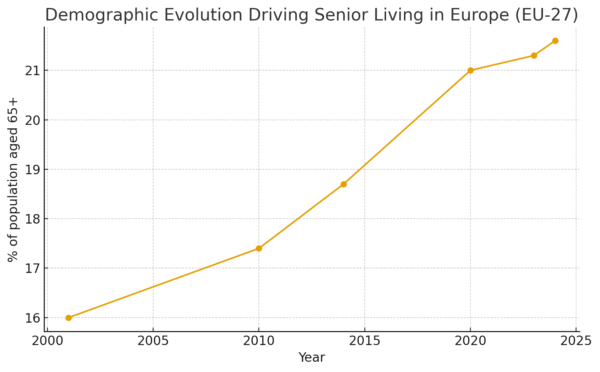Demographic, social, and economic transformation is driving a paradigm shift in how we understand senior living. Senior Living has become both a real need and a rapidly expanding market.
We are no longer just talking about nursing homes. We are talking about living spaces designed for active older adults who seek quality, independence, and community. Spaces that move away from the institutional and closer to the human.
Psychologist Urie Bronfenbrenner once said that no individual can be understood apart from their environment. And if there is one space that directly shapes well-being, it is the home. As Gaston Bachelard reminded us, the house is our first universe, the foundation on which emotional and social life is built. That is why senior housing is not only a functional matter, but also a cultural, psychological, and emotional one.
Well-being at this stage of life can be approached from two perspectives:
-
The hedonic perspective, centered on pleasure and life satisfaction.
-
The eudaimonic perspective, linked to personal growth, autonomy, connection, and competence (Ryan & Deci, 2001).

Indicator: “Proportion of population aged 65 and over (demo_pjanind)”.
In this sense, the baby boomer generation—protagonists of major social transformations—faces the challenge of aging with resilience, seeking simple pleasures, meaningful connections, and shared projects. For them, models such as Senior Living, cohousing, or service apartments represent alternatives that enable active and healthy aging, while mitigating risks such as unwanted loneliness or boredom—just as geriatrician Bill Thomas advocated with the Eden Alternative.
In this context, design plays a key role:
-
Well-being and community → creating environments that foster interaction, coexistence, and a sense of belonging.
-
Human-centered and accessible design → solutions that support everyday life with comfort, beauty, and functionality.
-
Technology and sustainability → integrating innovations that enhance autonomy and reduce environmental impact.
-
Location and surroundings → connected urban or semi-urban environments that provide proximity to services and quality of life.
At Alpha Contract, we understand Senior Living as a present-day reality that requires concrete solutions. Our new collection is inspired by these priorities to offer furniture and design solutions that are flexible, sustainable, and people-centered.
The challenge is already here: to design the spaces that will shape senior living today… and tomorrow.